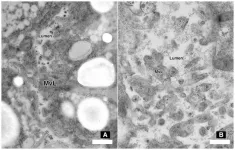(Press-News.org) The Lancet Diabetes & Endocrinology: Global Commission proposes major overhaul of obesity diagnosis, going beyond BMI to define when obesity is a disease.
Current medical approaches to diagnosing obesity rely on BMI which is not a reliable measure of health or illness at the individual level. This can result in misdiagnosis with negative consequences for people living with obesity and wider society.
The Commission on Clinical Obesity recommends a new, nuanced approach where measures of body fat - for example, waist circumference or direct fat measurement - in addition to BMI are used to detect obesity, therefore reducing the risk of misclassification.
Additionally, the authors introduce two new diagnostic categories of obesity based on objective measures of illness at the individual level; ‘clinical obesity’ (a chronic disease associated with ongoing organs’ dysfunction due to obesity alone) and ‘pre-clinical obesity’ (associated with a variable level of health risk, but no ongoing illness).
The Commission authors call for all people living with obesity to receive personalised health advice and evidence-based care when needed - free of stigma and blame - with different strategies for clinical obesity and pre-clinical obesity.
A global Commission, published in The Lancet Diabetes & Endocrinology and endorsed by more than 75 medical organisations around the world [1], presents a novel, nuanced approach to diagnose obesity, based on other measures of excess body fat in addition to body mass index (BMI), and objective signs and symptoms of ill health at the individual level.
The proposal is designed to address limitations in the traditional definition and diagnosis of obesity that hinder clinical practice and healthcare policies, resulting in individuals with obesity not receiving the care they need. By providing a medically coherent framework for disease diagnosis, the Commission also aims to settle the ongoing dispute around the idea of obesity as a disease, which has been at the centre of one of most controversial and polarising debates in modern medicine.
Commission chair, Professor Francesco Rubino, King's College London (UK) says, “The question of whether obesity is a disease is flawed because it presumes an implausible all-or-nothing scenario where obesity is either always a disease or never a disease. Evidence, however, shows a more nuanced reality. Some individuals with obesity can maintain normal organs’ function and overall health, even long term, whereas others display signs and symptoms of severe illness here and now.
“Considering obesity only as a risk factor, and never a disease, can unfairly deny access to time-sensitive care among people who are experiencing ill health due to obesity alone. On the other hand, a blanket definition of obesity as a disease can result in overdiagnosis and unwarranted use of medications and surgical procedures, with potential harm to the individual and staggering costs for society.
“Our reframing acknowledges the nuanced reality of obesity and allows for personalised care. This includes timely access to evidence-based treatments for individuals with clinical obesity, as appropriate for people suffering from a chronic disease, as well as risk-reduction management strategies for those with pre-clinical obesity, who have an increased health risk, but no ongoing illness. This will facilitate a rational allocation of healthcare resources and a fair and medically meaningful prioritisation of available treatment options.”
With over one billion people in the world now estimated to be living with obesity [2], the Commission’s proposal provides an opportunity for health systems globally to adopt a universal, clinically relevant definition of obesity and a more accurate method for its diagnosis.
Current approaches to diagnosing obesity are ineffective
There is an ongoing debate among clinicians and policymakers over the current diagnostic approach to obesity, which is prone to misclassification of excess body fat and misdiagnosis of disease.
Part of the issue is due to obesity being currently defined by BMI, with a BMI of over 30 Kg/m2 considered as an indicator of obesity for people of European descent. Different, country-specific BMI cutoffs are also used to account for ethnic variability of obesity-related risk.
Although BMI is useful for identifying individuals at increased risk of health issues, the Commission highlights that BMI is not a direct measure of fat, does not reflect its distribution around the body and does not provide information about health and illness at the individual level.
“Relying on BMI alone to diagnose obesity is problematic as some people tend to store excess fat at the waist or in and around their organs, such as the liver, the heart or the muscles, and this is associated with a higher health risk compared to when excess fat is stored just beneath the skin in the arms, legs or in other body areas. But people with excess body fat do not always have a BMI that indicates they are living with obesity, meaning their health problems can go unnoticed. Additionally, some people have a high BMI and high body fat but maintain normal organ and body functions, with no signs or symptoms of ongoing illness.” says Commissioner Professor Robert Eckel, University of Colorado Anschutz Medical Campus (USA).
Beyond body mass index
Whilst recognising BMI is useful as a screening tool to identify people who are potentially living with obesity, the authors recommend moving away from detecting obesity based on BMI alone. Instead, they recommend confirmation of excess fat mass (obesity) and its distribution around the body using one of the following methods:
● At least one measurement of body size (waist circumference, waist-to-hip ratio or waist-to-height ratio) in addition to BMI
● At least two measurements of body size (waist circumference, waist-to-hip ratio or waist-to-height ratio) regardless of BMI
● Direct body fat measurement (such as by a bone densitometry scan or DEXA) regardless of BMI
● In people with very high BMI (e.g. >40 Kg/m2) excess body fat can be pragmatically assumed.
Two new categories of obesity: 'clinical obesity' and 'pre-clinical obesity'
The Commission also provides a new model for disease diagnosis in obesity based on objective measures of illness at the individual level.
Clinical obesity is defined as a condition of obesity associated with objective signs and/or symptoms of reduced organ function, or significantly reduced ability to conduct standard day-to-day activities, such as bathing, dressing, eating and continence, directly due to excess body fat. People with clinical obesity should be considered as having an ongoing chronic disease and receive appropriate management and treatments.
The Commission sets out 18 diagnostic criteria for clinical obesity in adults (see appendix figure 1) and 13 specific criteria for children & adolescents (see appendix figure 2), including:
● Breathlessness caused by effects of obesity on the lungs
● Obesity-induced heart failure
● Knee or hip pain, with joint stiffness and reduced range of motion as a direct effect of excess body fat on the joints
● Certain alterations of bones and joints in children and adolescents limiting movement
● Other signs and symptoms caused by dysfunction of other organs including kidneys, upper airways, metabolic organs, nervous, urinary and reproductive systems and the lymph system in the lower limbs
Pre-Clinical obesity is a condition of obesity with normal organ function. People living with pre-clinical obesity therefore do not have ongoing illness, although they have a variable but generally increased risk of developing clinical obesity and several other non-communicable diseases (NCDs) in the future, including type 2 diabetes, cardiovascular disease, certain types of cancer and mental illness, among others. As such, they should be supported to reduce the risk of potential disease
“The Commission’s new diagnostic criteria fill a gap in the notion of obesity diagnoses as they enable clinicians to differentiate between health and illness at the individual level. We hope that the broad endorsement of the new framework and diagnosis of obesity by many important scientific societies from around the world will ensure that a systematic clinical assessment of obesity becomes a requirement in health systems globally,” says Commissioner Dr Gauden Galea, WHO Regional Office for Europe (Europe).
People living with obesity need personalised care
The Commission’s reframing of obesity is designed to ensure that all people living with obesity receive appropriate health advice and evidence-based care when needed, with different strategies for clinical obesity and pre-clinical obesity.
People with clinical obesity should receive timely, evidence-based treatment, with the aim to fully regain or improve the body functions reduced by excess body fat, rather than solely to lose weight. The type of treatment and management for clinical obesity – lifestyle, medication, surgery, etc –should be informed by individual risk: benefit assessments and determined by an active discussion with the patient.
Health insurers worldwide often require evidence of other conditions associated with obesity (e.g. type 2 diabetes) to provide coverage of obesity therapies. As a distinct chronic illness itself, clinical obesity should not necessitate the presence of another disease to justify coverage.
People living with pre-clinical obesity are at risk for future diseases but do not have ongoing health complications due to excess body fat. Accordingly, the approach to their care should aim at risk-reduction. Depending on the individual level of risk, this may require just health counselling and monitoring over time, or active treatment if necessary to reduce substantially high levels of risk.
“This nuanced approach to obesity will enable evidence-based and personalised approaches to prevention, management and treatment in adults and children living with obesity, allowing them to receive more appropriate care, proportional to their needs. This will also save healthcare resources by reducing the rate of overdiagnosis and unnecessary treatment,” says Commissioner Professor Louise Baur, University of Sydney (Australia).
The Commission involved 56 world leading experts across a broad range of medical specialties, including endocrinology, internal medicine, surgery, biology, nutrition and public health, representing many countries and diverse healthcare systems. The Commission also included people living with obesity and specifically considered the potential impact of the new definitions of obesity on widespread societal stigma.
"Studies show that the way obesity is usually talked about adds to weight stigma, making it harder to prevent, manage and treat. The approach proposed by this Commission can help clear up misconceptions and reduce stigma. We also urge better training for healthcare workers and policymakers to tackle this issue," says Joe Nadglowski, patient advocate and Commissioner, Obesity Action Coalition (USA).
NOTES TO EDITORS
There was no industrial grants or other funding for this initiative. King’s Health Partners hosted the initiative and provided logistical and personnel support to facilitate administrative work and the delphi-like consensus-development process. For a full list of researchers and their institutions see the Commission report.
There will be a UK Science Media Centre press briefing at 12 noon GMT on Mon 13th January, please email Fiona Lethbridge (lethbridge@sciencemediacentre.org) for more information.
The Commission will be launched at a public live-streamed event at 1pm-5pm GMT on Thursday 16th January 2025. Register here.
Quotes from Authors cannot be found in the text of the Commissino report, but have been supplied for the press release.
Translations of this press release in Spanish, Italian, Portuguese and Arabic are available here.
References:
[1] For a full list of medical organisations endorsing the Commission see appendix 2 (pp 2–3).
[2] https://www.thelancet.com/journals/lancet/article/PIIS0140-6736(23)02750-2/fulltext
Resources from the World Obesity Federation to support discussing obesity in the media:
● The do’s and don’ts when talking about obesity
● Image use and obesity: recommendations
● Visit www.worldobesity.org/resources/image-bank for a selection of free to download images available for use.
The labels have been added to this press release as part of a project run by the Academy of Medical Sciences seeking to improve the communication of evidence. For more information, please see: http://www.sciencemediacentre.org/wp-content/uploads/2018/01/AMS-press-release-labelling-system-GUIDANCE.pdf if you have any questions or feedback, please contact The Lancet press office pressoffice@lancet.com
Post-embargo link: https://www.thelancet.com/commissions/clinical-obesity
END
THE LANCET DIABETES & ENDOCRINOLOGY: Global Commission proposes major overhaul of obesity diagnosis, going beyond BMI to define when obesity is a disease.
2025-01-15
ELSE PRESS RELEASES FROM THIS DATE:
Floating solar panels could support US energy goals
2025-01-14
Federal reservoirs could help meet the country’s solar energy needs, according to a new study published in Solar Energy.
For the study, Evan Rosenlieb and Marie Rivers, geospatial scientists at the U.S. Department of Energy National Renewable Energy Laboratory (NREL), as well as Aaron Levine, a senior legal and regulatory analyst at NREL, quantified for the first time exactly how much energy could be generated from floating solar panel projects installed on federally owned or regulated reservoirs. (Developers can find specific details for each reservoir on the website AquaPV.)
And the potential is surprisingly ...
Long before the L.A. fires, America’s housing crisis displaced millions
2025-01-14
A new USC study reveals that the challenges that led to a national shortage of affordable housing and soaring home prices were set in motion long ago — and could have been foreseen.
The researchers behind the study say that the problem will only worsen as more natural disasters — such as the devastating Los Angeles area wildfires and large hurricanes — flatten entire communities. Los Angeles County officials estimate that more than 10,000 homes and businesses have been lost so far to the fires that erupted across the region last week.
“A ...
Breaking barriers: Collaborative research studies binge eating disorders in older Hispanic women
2025-01-14
SAN ANTONIO, Jan. 14, 2025 – Scientists from The University of Texas Health Science Center at San Antonio (UT Health San Antonio) and Trinity University are partnering with the San Antonio Food Bank for a four-year, $2.2 million study on eating disorders in older Hispanic women.
A grant from the National Institute on Aging of the National Institutes of Health is funding this transformative study, which aims to redefine how the intersection of binge eating, food insecurity and health disparities among ...
UVA receives DURIP grant for cutting-edge ceramic research system
2025-01-14
The University of Virginia School of Engineering and Applied Science is set to revolutionize materials science with the development of a state-of-the-art electromagnetic levitation (EML) system, funded by a competitive Defense University Research Instrumentation Program (DURIP) grant. Designed to operate in extreme conditions, the system enables researchers to study ultra-high-temperature ceramics (UHTCs) in their solid and molten states — unlocking new possibilities for aerospace, defense and industrial applications.
Rethinking High-Temperature Research
Traditional methods of studying UHTCs are limited by the challenges of chemical contamination at extreme temperatures. The EML system’s ...
Gene editing extends lifespan in mouse model of prion disease
2025-01-14
Researchers at the Broad Institute of MIT and Harvard have developed a gene-editing treatment for prion disease that extends lifespan by about 50 percent in a mouse model of the fatal neurodegenerative condition. The treatment, which uses base editing to make a single-letter change in DNA, reduced levels of the disease-causing prion protein in the brain by as much as 60 percent.
There is currently no cure for prion disease, and the new approach could be an important step towards treatments that prevent the disease or ...
Putting a lid on excess cholesterol to halt bladder cancer cell growth
2025-01-14
LA JOLLA (January 14, 2025)—Like all cancers, bladder cancer develops when abnormal cells start to multiply out of control. But what if we could put a lid on their growth?
Previous studies showed that a protein called PIN1 helps cancers initiate and progress, but its exact role in tumor development has remained unclear. Now, cancer biologists at the Salk Institute have discovered that PIN1 is a significant driver of bladder cancer and revealed that it works by triggering the synthesis of cholesterol—a membrane lipid essential for cancer cells to grow.
After mapping out the molecular pathway between PIN1 and ...
Genetic mutation linked to higher SARS-CoV-2 risk
2025-01-14
RIVERSIDE, Calif. -- Researchers have identified a novel genetic risk factor for SARS-CoV-2 infection, providing new insights into the virus’ ability to invade human cells. SARS-CoV-2 is the virus that spreads COVID-19.
The study, led by immunologist Declan McCole at the University of California, Riverside, shows that a loss-of-function variant in the phosphatase gene PTPN2, commonly associated with autoimmune diseases, can increase expression of the SARS-CoV-2 receptor ACE2, making cells more susceptible to viral invasion.
A loss-of-function ...
UC Irvine, Columbia University researchers invent soft, bioelectronic sensor implant
2025-01-14
Irvine, Calif., Jan. 14, 2025 — Researchers at the University of California, Irvine and New York’s Columbia University have embedded transistors in a soft, conformable material to create a biocompatible sensor implant that monitors neurological functions through successive phases of a patient’s development.
In a paper published recently in Nature Communications, the UC Irvine scientists describe their construction of complementary, internal, ion-gated, organic electrochemical transistors that are more amenable ...
Harnessing nature to defend soybean roots
2025-01-14
The microscopic soybean cyst nematode (SCN) may be small, but it has a massive impact. This pest latches onto soybean roots, feeding on their nutrients and leaving a trail of destruction that costs farmers billions in yield losses each year. Unfortunately, current methods to combat SCN are faltering as the pest grows resistant to traditional controls. But new research is now offering a glimmer of hope.
A collaborative team of scientists from BASF Agricultural Solutions and the Advanced Bioimaging Laboratory at the Donald Danforth Plant Science Center are working on a potential solution: ...
Yes, college students gain holiday weight too—but in the form of muscle not fat
2025-01-14
With the holidays behind us, many Americans are seeing the numbers on the scale go up a pound or two. In fact, data shows that many American midlife and older adults gain 1 to 1.5 pounds over the November through January holiday period. Though not harmful on its own, even a small amount of holiday weight gain in the form of fat can negatively affect health. People often fail to lose the extra weight, which leads to significant cumulative weight gain over the years and contributes to health concerns.
Based on new research, we now know that college students gain the same amount of weight as older ...




